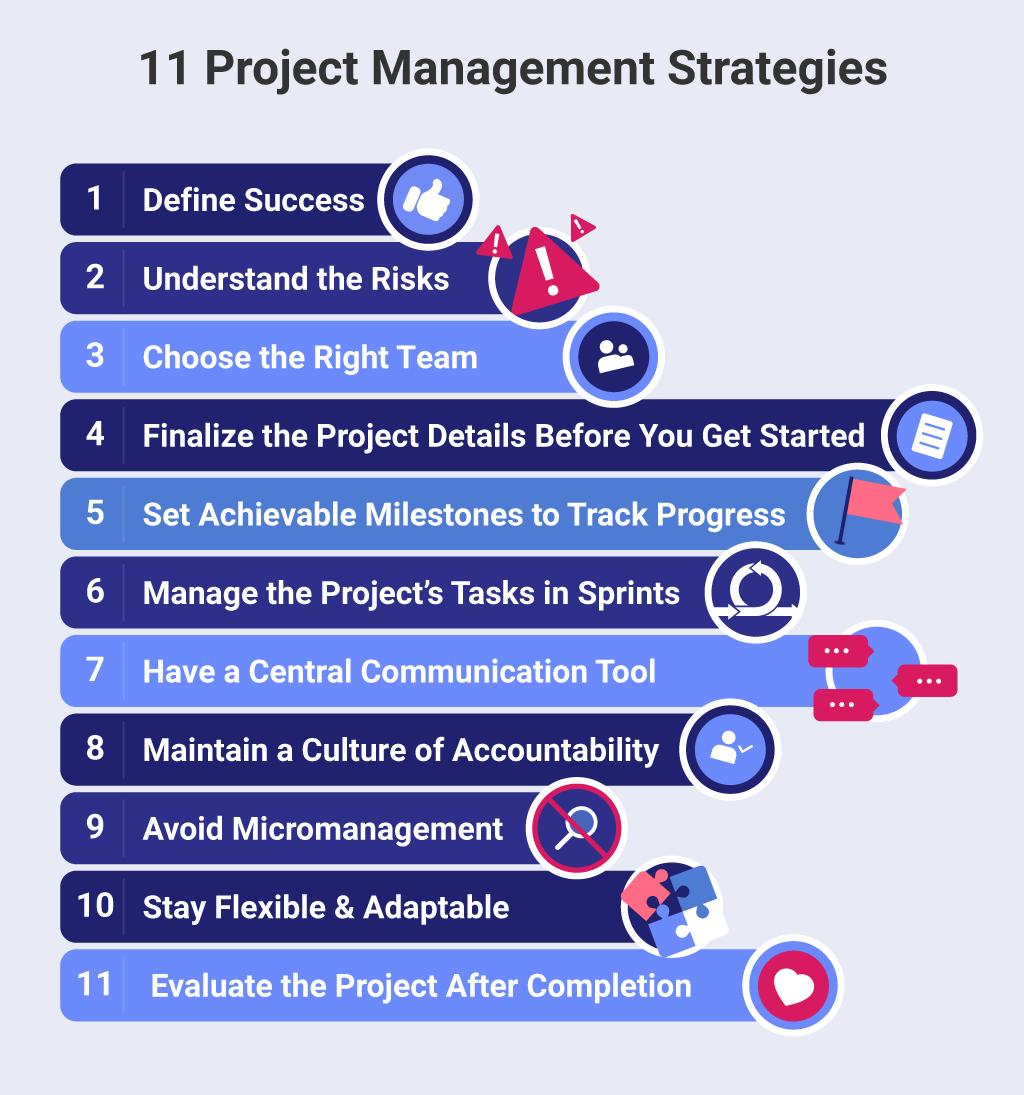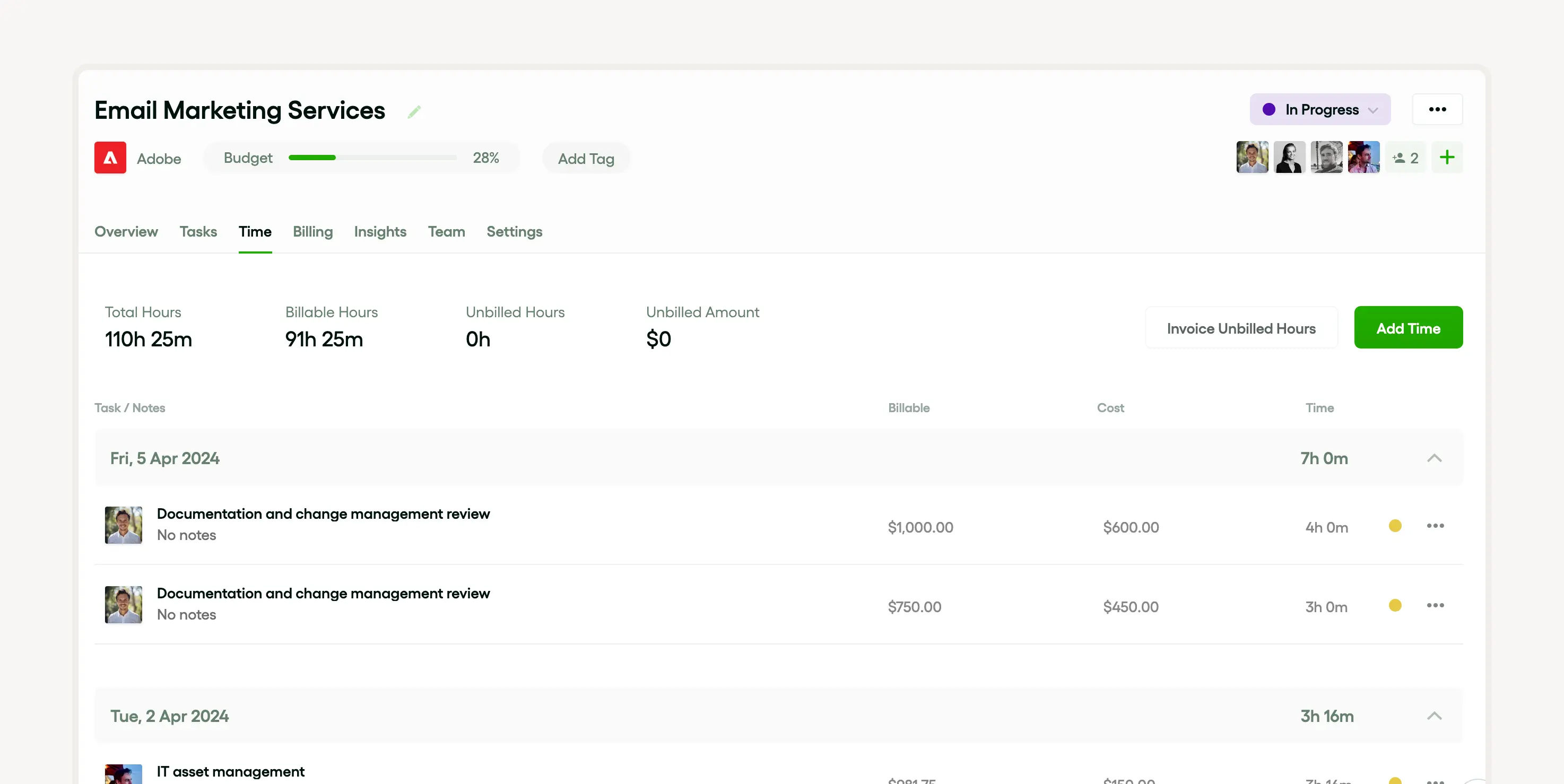Successful project management relies on strategic planning, effective communication, and consistent monitoring of progress.
A well-structured project plan is vital, outlining project goals, the necessary tasks, and their prioritization; Gantt charts and other project management software can facilitate this process. Time tracking and risk management are also essential to deliver the project on time while mitigating potential issues.
Running effective project management processes also depends on team skills and project experience. Open communication within the team fosters collaboration and ensures that everyone is on the same page. Regular check-ins to monitor progress maintain momentum and allow rapid response to any challenges that arise during execution.
Understanding the importance of project management

Project management is key to hitting project targets. It’s about making a solid plan, keeping an eye on how things are going, and talking clearly with the team. With project management, you make sure every part of the project gets the focus and stuff it needs.
Important parts of project management are using Gantt charts to watch the time, using software to make things easier, and getting the team’s skills sharp. It’s also about being ready for any hiccups and having plans ready just in case.
Defining project management
Project management is about working together to plan, do, and check tasks to reach certain goals. It uses tools like Gantt charts and strategies like risk management to keep the project on track from start to finish.
It also needs clear talking to build up the team’s skills, work on the plan together, and keep tabs on progress. Project management often means picking the most important tasks to work on first, using what you have wisely. Good software can make the whole thing run smoother.
Why project management is crucial for agencies
For agencies, project management is super important because it sets out a clear plan. This lets you watch how the project is going and make sure you’re moving toward your goals. Good project management uses tools like Gantt charts and software to help with planning and doing the work, making the team better and keeping everyone in the loop.
It’s not just about keeping risks in check and choosing which tasks to do first. It also uses what you’ve learned from past projects to make things run better down the road.
Key strategies for successful project management

For project management to work well, you need great planning, clear talking, and smart checking on how things are going. Start with a full plan that lays out what you want to do, when, and who’s doing what. Using software for project management, like Gantt charts and keeping track of time, helps keep an eye on the project.
Talking openly keeps everyone on the same page and working together well. It also helps the team get better at what they do. Plus, having a plan for risks means you’re ready for any bumps in the road. Choosing which tasks are most important and when they need to be done is key to doing things right and getting the most from the project.
Setting clear goals and objectives
Good project management starts with setting clear goals. This is the base of a solid plan and helps you pick the right tasks to work on. With clear goals, the team can use their skills and what they’ve learned to head in the right direction.
Tools like software for project management and Gantt charts help with planning and doing the work by showing how things are moving along. These tools, along with talking openly, are important for handling risks.
Project management isn’t just about keeping track of time. It’s about always looking at your goals and tweaking them to get where you want to go.
Effective communication strategies
Managing projects well means making a full plan, making sure everyone talks to each other, and using software to watch how the project is going. This helps with picking the right tasks, making the team better, and handling risks.
Using Gantt charts and tools for keeping track of time helps make sure you do things just right, plan well, and hit your project targets. Learning from past projects can also help make your project management even better.
Importance of risk management
Risk management is a big part of managing projects because it helps make a full plan and hit your project targets. It’s about figuring out which tasks might cause problems and finding good ways to deal with those risks.
Risk management is a key part of project management. It involves keeping a close watch on progress, making sure the team talks to each other, and using software like gantt charts to keep track of time. Getting risk management right can really help the team’s skills, what they learn from the project, and how well the project is planned and done.
Utilizing agile methodologies
Using agile methods means planning well, doing things on time, and regularly checking on time spent. You can show these methods clearly with Gantt charts, which helps the team pick the right tasks and makes managing the project more efficient.
Open talking is also a must in agile. It lets the team share what they’ve learned, stay focused on project goals, make decisions faster, and keep an eye on progress. Using project management software can make talking easier and help the team get even better at handling risks.
Essential habits for successful project managers

Successful project management hinges on a range of habits, foremost Amongst Them are open communication, monitoring progress, and prioritizing tasks. It's essential to maintain an open channel of communication for effective team management, keeping everyone aligned with project goals.
Furthermore, using project management processes such as Gantt charts and project management software can Greatly Influence the project plan's successful execution. They provide visibility, simplify time tracking and aid in risk management. Lastly, a successful project manager always prioritizes tasks based on their impact and urgency, ensuring steady progress based on project experience.
Proactive problem-solving
Proactive problem-solving is a crucial component of project management. It involves prioritizing tasks and using project management software to monitor progress against the project plan effectively. This process helps prevent potential issues and enables the execution of project goals according to the plan.
Key attributes Including Open communication, Gantt charts for time tracking, and insight from previous project Experience Are employed. Besides, risk management is integral to proactive problem-solving, aiding in the timely identification and mitigation of project risks.
Project management processes and team skills are also honed to ensure smooth planning and effective handling of project complications.
Continuous learning and improvement
Effective project management necessitates continuous learning and improvement for optimum project plan execution and goal attainment. Using project management software aids in monitoring progress and time tracking, effectively enhancing team skills and prioritizing tasks. Moreover, it provides a platform for open communication, ensuring everyone remains aligned with the project goals.
Project experience plays a pivotal role in risk management, as it provides insight into potential pitfalls and necessitates proper planning. Furthermore, Gantt charts, a crucial element of project management processes, can be utilized to visually track and manage progress towards completion.
Building strong team relationships
Building strong team relationships is fundamental to effective project management. The foundation of this lies in establishing open communication, aligned project goals, and setting a clear project plan. This allows members to have a common understanding of expectations and contributes to the overall project experience.
Project management software tools such as Gantt charts help to monitor progress and aid in time tracking. Enhanced team skills can be achieved through continuous learning and adaptation of project management processes, planning, execution, and prioritizing tasks. Moreover, risk management also plays an integral role in strengthening team dynamics.
Role of technology in project management

The role of technology in project management is vital as it simplifies project management processes and enables the project team to achieve project goals effectively and efficiently.
Project management software is often used to plan, execute and monitor the progress of a project. This includes gantt charts for project planning, time tracking for prioritizing tasks, and open communication channels for sharing project experience and boosting team skills.
Additionally, technology also plays a crucial role in risk management; it helps identify potential problems and establish control measures in advance to prevent any deviation from the project plan.
Benefits of using project management software
Project management software offers numerous benefits to business operations. First, it simplifies project management processes, including planning and execution. Software tools can help create a project plan, monitor progress, and ensure that project goals are met within the stipulated timeline.
Moreover, it promotes open communication among team members, simultaneously improving team skills and optimizing workflow by prioritizing tasks. Features like Gantt charts, time tracking, and risk management can enhance project experience, making it easier to control and analyze every aspect of your projects.
Choosing the right project management software: Bonsai, Trello vs Asana
Selecting the right project management software depends on your team's needs, project goals, and previous project experience.

Bonsai stands out as a versatile tool that caters to the needs of diverse teams and leaders. It offers a user-friendly interface, robust task management, and efficient time tracking, which are essential for project success.
Trello is a flexible tool that highlights open communication and simplicity, making it more suitable for smaller teams or projects. It uses a Kanban board style to help you organize and prioritize tasks.
On the other hand, Asana is perfect for larger teams dealing with complex project management processes. It offers robust features like Gantt charts for project planning and execution, time tracking to monitor Progress, And advanced risk management tools. The choice between Trello and Asana ultimately depends on your project’s complexity and team skills.
Real-life examples of successful project management
The construction of the Burj Khalifa in Dubai is a monumental example of successful project management. The project team utilized project management processes such as prioritizing tasks and used project management software which included Gantt charts for time tracking and open communication among various teams. This helped them monitor progress effectively.
Another notable example Includes The creation of the iPhone. Apple's project plan defined clear project goals and prioritized open communication among their cross-functional teams. With a focus on planning, execution, and risk management, Apple leveraged their team skills and project experience to revolutionize the smartphone market.
How Google manages projects successfully
Google successfully manages projects through meticulous project management processes, incorporating crucial elements such as project goals, plan creation, and execution. A well-defined project plan lays out the steps to be taken, prioritizing tasks based on importance and urgency, while gantt charts are used to schedule and monitor progress.
Google also emphasizes risk management strategies to navigate potential challenges swiftly.
Employing sophisticated project management software enables effective time tracking and facilitates open communication among team members, thus aligning their diverse team skills to the project's requirements.
Learning from past project experiences is also a critical part of google's project management strategies, driving continuous improvement.
Project management success at NASA
At NASA, the success in project management is attributed to strategic project management processes which involve meticulous planning, prioritizing tasks within the project plan, and rigorous execution. The use of project management software assists in time tracking and in the creation of gantt charts to clearly outline and monitor progress towards project goals.
Risk management is also critical, as it allows for the anticipation of potential issues and the establishment of mitigation strategies. In addition, team skills and project experience are highly valued, fostering a culture of open communication and promoting a shared understanding of project objectives and progress.
Common pitfalls in project management and how to avoid them
Avoiding common traps in managing projects starts with setting clear goals. This stops confusion right from the start. Keeping everyone talking is also key to keeping things on track. And don’t forget about risks – plan for them so they don’t knock you off course.
Smart project management dodges these traps. Tools like time tracking, Gantt charts, and software help with planning, doing, watching progress, and picking the right tasks. They also help see problems coming, which makes the team better and the project richer.
Scope creep and how to manage it
Scope creep is when a project starts to grow beyond what was first planned. It can mess with your goals, cost more, and cause delays. To stop this, keep talking, plan well, and focus on the most important tasks.
Sticking to the project plan helps keep scope creep away. Tools like Gantt charts and software are good for keeping an eye on time and progress. Building up skills in risk management and learning from what you’ve done before are also big in keeping scope creep under control.
Avoiding communication breakdowns
Good project management really needs open communication to stop misunderstandings. It’s important to have a clear plan that shows what you want to achieve and how. Checking on progress often, using tools like Gantt charts and software, is a must. This helps with time tracking and sharing what everyone’s learned.
Risk management is a big part of making sure a project goes well. It’s about making a plan and doing things to handle tasks and stop problems before they start. Using these ways, project managers can steer clear of communication issues and move the project smoothly to the end.
Conclusion: the path to project management success
In conclusion, successful project management revolves around creating an efficient project plan, diligently monitoring progress, and maintaining open communication throughout. Utilization of tools such as Gantt charts and project management software aids in time tracking and measuring project progress.






